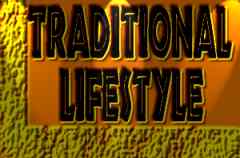Preserving
There was a large amount of time spent on hunting and preserving deer and other wild game. The game also provided clothes, tools and other implements.
First, a rack for smoking meat was built using Douglas fir and willow sticks. The rack used horizontal poles that were about five feet from the ground and a fire was made underneath the rack. Hardwoods such as alder and cottonwood were used in the fire and were left to smolder to cure the meat properly.
The meat was cut into large slabs, an inch and a half thick and then was laid on the cutting surface with the muscle grain going from the left to the right. The meat was cut
into strips from the top to an inch and a half from the bottom and then was turned upside down and cut between the first cuts to stretch the meat strip. The food was then pulled apart into one large strip that was about two feet in length, depending on the slab size. The meat was then hung over the smoldering fire and turned over every few hours. When it was necessary, the rack was covered up by tree branches or birch bark. This was to keep rain out and to shade the meat from the sun. Salmon and fish are an important food for the Shuswap people. This food source was either speared or netted from the local rivers or streams.
There are a few different methods of drying fish which depended on the area where the Secwepemc was from. The fish had to be gutted and cleaned first and then the heads and tails were removed. It was then cut into two halves and the bones were removed and the excessive meat was trimmed. The halves were cut down to the skin and into strips. A hole was then cut near the tail end so it could hang from a branch on the rack. The side of fish was snapped like a whip to to stretch the skin and this would allow the meat to dry evenly. The sides of fish would then hang to dry for about two weeks depending on the weather.
Smoking fish was much like smoking meat; it was gutted and cleaned first. The head and tail were removed and then the fish was filleted and all of the bones were taken out. The fish was almost split into two parts but part of the skin was saved to hold the two sides together. Holes were made near the dorsal and the pectoral fins so that the willow sticks stretched the fish so the meat would cure evenly. Once this was done another stick would be pierced through the hole in the tail and then hung on a rack in a smoke shack. Fish heads and meaty bones were also smoked for times of hardships that may befall the band. A fire of alder or hickory wood was placed underneath the meat to cure it. To prepare the fish it would be placed over an open flame to heat the oils in the fish which would moisten the meat.
Home / Table of Contents Previous
